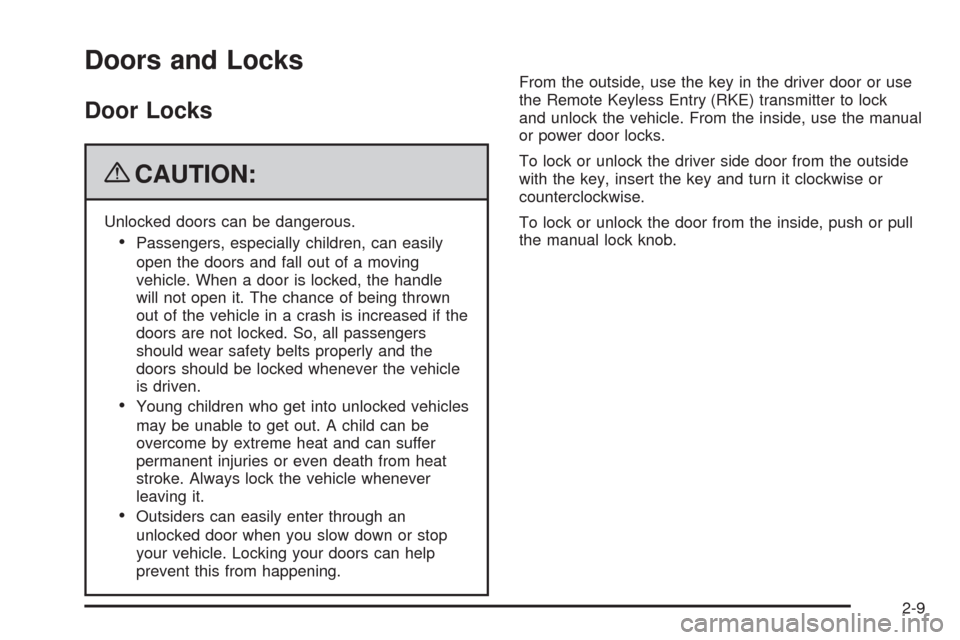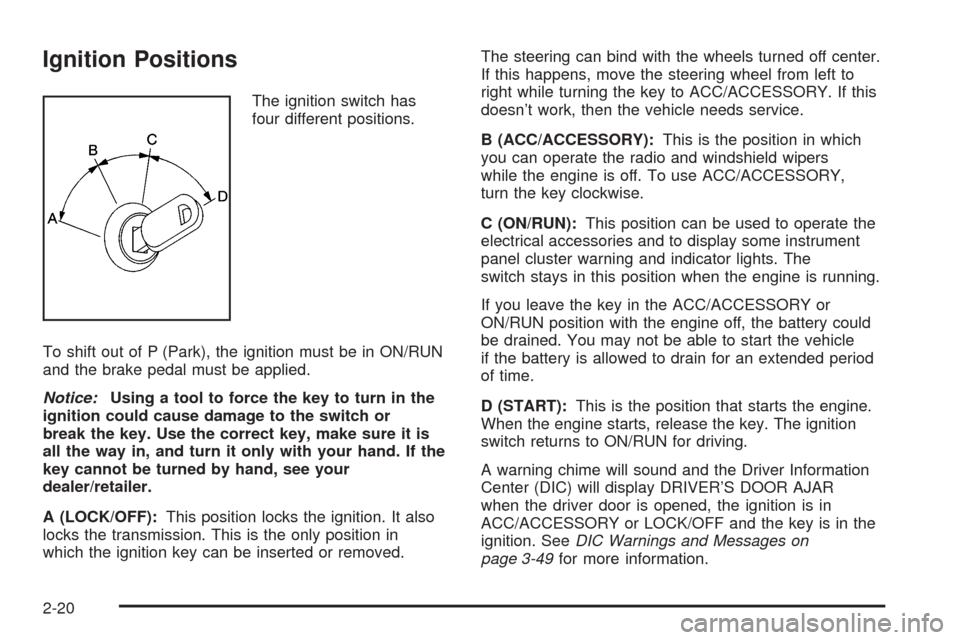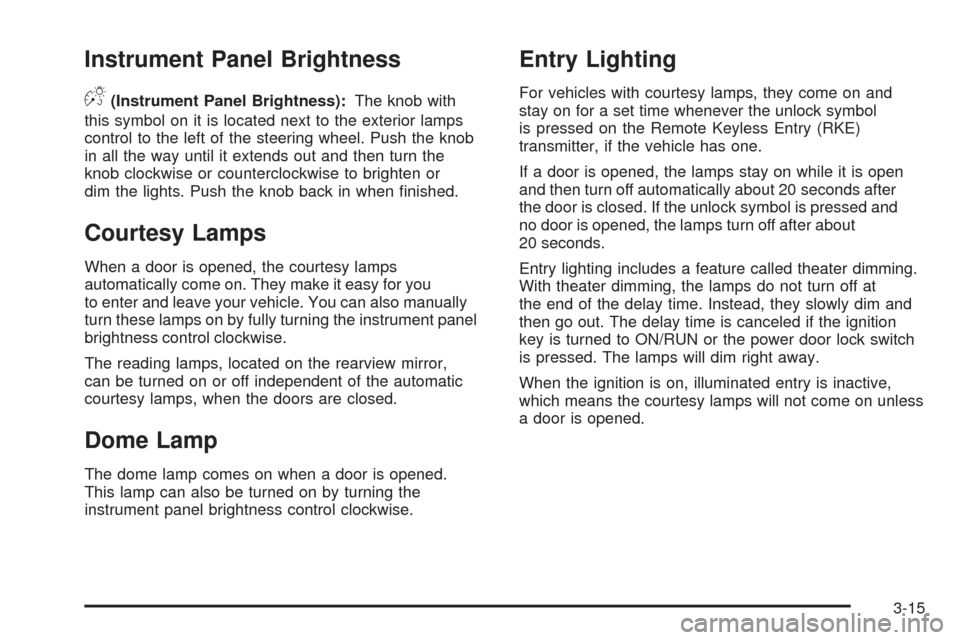2009 CHEVROLET IMPALA clock
[x] Cancel search: clockPage 87 of 406

Doors and Locks
Door Locks
{CAUTION:
Unlocked doors can be dangerous.
Passengers, especially children, can easily
open the doors and fall out of a moving
vehicle. When a door is locked, the handle
will not open it. The chance of being thrown
out of the vehicle in a crash is increased if the
doors are not locked. So, all passengers
should wear safety belts properly and the
doors should be locked whenever the vehicle
is driven.
Young children who get into unlocked vehicles
may be unable to get out. A child can be
overcome by extreme heat and can suffer
permanent injuries or even death from heat
stroke. Always lock the vehicle whenever
leaving it.
Outsiders can easily enter through an
unlocked door when you slow down or stop
your vehicle. Locking your doors can help
prevent this from happening.From the outside, use the key in the driver door or use
the Remote Keyless Entry (RKE) transmitter to lock
and unlock the vehicle. From the inside, use the manual
or power door locks.
To lock or unlock the driver side door from the outside
with the key, insert the key and turn it clockwise or
counterclockwise.
To lock or unlock the door from the inside, push or pull
the manual lock knob.
2-9
Page 98 of 406

Ignition Positions
The ignition switch has
four different positions.
To shift out of P (Park), the ignition must be in ON/RUN
and the brake pedal must be applied.
Notice:Using a tool to force the key to turn in the
ignition could cause damage to the switch or
break the key. Use the correct key, make sure it is
all the way in, and turn it only with your hand. If the
key cannot be turned by hand, see your
dealer/retailer.
A (LOCK/OFF):This position locks the ignition. It also
locks the transmission. This is the only position in
which the ignition key can be inserted or removed.The steering can bind with the wheels turned off center.
If this happens, move the steering wheel from left to
right while turning the key to ACC/ACCESSORY. If this
doesn’t work, then the vehicle needs service.
B (ACC/ACCESSORY):This is the position in which
you can operate the radio and windshield wipers
while the engine is off. To use ACC/ACCESSORY,
turn the key clockwise.
C (ON/RUN):This position can be used to operate the
electrical accessories and to display some instrument
panel cluster warning and indicator lights. The
switch stays in this position when the engine is running.
If you leave the key in the ACC/ACCESSORY or
ON/RUN position with the engine off, the battery could
be drained. You may not be able to start the vehicle
if the battery is allowed to drain for an extended period
of time.
D (START):This is the position that starts the engine.
When the engine starts, release the key. The ignition
switch returns to ON/RUN for driving.
A warning chime will sound and the Driver Information
Center (DIC) will display DRIVER’S DOOR AJAR
when the driver door is opened, the ignition is in
ACC/ACCESSORY or LOCK/OFF and the key is in the
ignition. SeeDIC Warnings and Messages on
page 3-49for more information.
2-20
Page 124 of 406

Oil Pressure Light.........................................3-39
Security Light...............................................3-39
Fog Lamp Light............................................3-40
Cruise Control Light......................................3-40
Highbeam On Light.......................................3-40
Fuel Gage...................................................3-41
Driver Information Center (DIC).......................3-42
DIC Operation and Displays...........................3-42
DIC Compass..............................................3-47
DIC Warnings and Messages.........................3-49
DIC Vehicle Customization.............................3-57Audio System(s).............................................3-63
Setting the Clock..........................................3-64
Radio(s)......................................................3-66
Using an MP3..............................................3-77
XM Radio Messages.....................................3-81
Bluetooth
®...................................................3-82
Theft-Deterrent Feature..................................3-93
Audio Steering Wheel Controls.......................3-94
Radio Reception...........................................3-95
Backglass Antenna.......................................3-96
XM™ Satellite Radio Antenna System.............3-96
Section 3 Instrument Panel
3-2
Page 137 of 406

Instrument Panel Brightness
D(Instrument Panel Brightness):The knob with
this symbol on it is located next to the exterior lamps
control to the left of the steering wheel. Push the knob
in all the way until it extends out and then turn the
knob clockwise or counterclockwise to brighten or
dim the lights. Push the knob back in when �nished.
Courtesy Lamps
When a door is opened, the courtesy lamps
automatically come on. They make it easy for you
to enter and leave your vehicle. You can also manually
turn these lamps on by fully turning the instrument panel
brightness control clockwise.
The reading lamps, located on the rearview mirror,
can be turned on or off independent of the automatic
courtesy lamps, when the doors are closed.
Dome Lamp
The dome lamp comes on when a door is opened.
This lamp can also be turned on by turning the
instrument panel brightness control clockwise.
Entry Lighting
For vehicles with courtesy lamps, they come on and
stay on for a set time whenever the unlock symbol
is pressed on the Remote Keyless Entry (RKE)
transmitter, if the vehicle has one.
If a door is opened, the lamps stay on while it is open
and then turn off automatically about 20 seconds after
the door is closed. If the unlock symbol is pressed and
no door is opened, the lamps turn off after about
20 seconds.
Entry lighting includes a feature called theater dimming.
With theater dimming, the lamps do not turn off at
the end of the delay time. Instead, they slowly dim and
then go out. The delay time is canceled if the ignition
key is turned to ON/RUN or the power door lock switch
is pressed. The lamps will dim right away.
When the ignition is on, illuminated entry is inactive,
which means the courtesy lamps will not come on unless
a door is opened.
3-15
Page 142 of 406

Climate Controls
Climate Control System
The heating, cooling, defrost, defog and ventilation
can be controlled with this system. For vehicles
with heated seats, seeHeated Seats on page 1-6.
A. Fan Control
B. Outside Air
C. Recirculation
D. Air Delivery Mode
ControlE. Air Conditioning
F. Heated Seats
G. Driver and Passenger
Temperature Controls
H. Rear Window
DefoggerTemperature Control:Turn the thumbwheels up or
down to increase or decrease the temperature on
the driver’s side or the passenger side of the vehicle.
9(Fan Control):Turn clockwise or counterclockwise
to increase or decrease the fan speed. Positioning the
knob between two modes, can select a combination of
those modes.
If the air�ow seems low when the fan is at the highest
setting, the passenger compartment air �lter may need
to be replaced. There will be some air�ow noticeable
from the various outlets when driving, even with the fan
in the off position. For more information, seePassenger
Compartment Air Filter on page 3-23andScheduled
Maintenance on page 6-4.
Air Delivery Mode Control:Turn clockwise or
counterclockwise to change the direction of the air�ow
inside the vehicle.
To change the current mode, select one of the following:
H(Vent):Air is directed to the instrument panel outlets.
)(Bi-Level):Air is divided between the instrument
panel outlets and the �oor outlets.
3-20
Page 186 of 406

Setting the Clock
Without Date Display
AM/FM Base Radio with a Single CD
Player
This radio has aHbutton for setting the time.
To set the time:
1. Press the
Hbutton until the hour begins �ashing
on display. Press
Ha second time and the
minutes begin �ashing on display.
2. To increase or decrease the time, do one of the
following while the hours or minutes are �ashing:
Turn thefknob.
Press¨SEEK or©SEEK.
Press\FWD orsREV.
3. Press the
Hbutton again until the clock display
stops �ashing to set the currently displayed time,
or wait �ve seconds until the �ashing stops and the
current time displayed is automatically set.
To change the time default setting from 12 hour to
24 hour, press the
Hbutton until 12H or 24H is displayed.
Once 12H or 24H is displayed, turn the
fknob to the
desired option to select the setting. Press the
Hbutton
again to apply the setting, or let the screen time out.
With Date Display
Single CD (MP3) Player
This radio has aHbutton for setting the time.
To set the time and date:
1. Turn the radio on.
2. Press the
Hbutton and the HR, MIN, MM, DD,
YYYY (hour, minute, month, day, and year) displays.
3. Press the pushbutton located under any one of the
tabs to be changed.
4. To increase the time or date, do one of the
following:
Press the pushbutton below the selected tab.
Turn thefknob clockwise.
Press¨SEEK.
Press\FWD.
5. To decrease the time or date, do one of the
following:
Turn thefknob counter-clockwise.
Press©SEEK.
PresssREV.
The date does not automatically display. To see the
date press the
Hbutton while the radio is on. The date
with display times out after a few seconds and goes
back to the normal radio and time display.
3-64
Page 187 of 406

Six-Disc CD (MP3) Player
This type of radio has a MENU button instead of the
clock button to set the time and date.
To set the time and date, follow these instructions:
1. Turn the radio on.
2. Press the MENU button.
3. Once the
Hoption displays, press the pushbutton
located under that tab. HR, MIN, MM, DD, YYYY
displays.
4. To increase the time or date, do one of the
following:
Press the pushbutton below the selected tab.
Turn thefknob clockwise.
Press¨SEEK.
Press\FWD.
5. To decrease the time or date, do one of the
following:
Turn thefknob counter-clockwise.
Press©SEEK.
PresssREV.The date does not automatically display. To see the
date press the MENU button and then the
Hbutton
while the radio is on. The date with display times
out after a few seconds and goes back to the normal
radio and time display.
To change the time default setting from 12 hour to
24 hour or to change the date default setting from
month/day/year to day/month/year:
1. Press the
Hbutton and then the pushbutton
located under the forward arrow tab. Once the time
12H and 24H, and the date MM/DD/YYYY (month,
day, and year) and DD/MM/YYYY (day, month, and
year) displays.
2. Press the pushbutton located under the desired
option.
3. Press the
Hor MENU button again to apply the
selected default, or let the screen time out.
3-65
Page 189 of 406

Radio Data System (RDS)
The radio may have the Radio Data System (RDS)
feature. RDS is available for use only on FM stations
that broadcast RDS information. This system relies upon
receiving speci�c information from these stations and
only works when the information is available. While the
radio is tuned to an FM-RDS station, the station name
or call letters display. In rare cases, a radio station can
broadcast incorrect information that causes the radio
features to work improperly. If this happens, contact the
radio station.
Playing the Radio
O
(Power/Volume):Press to turn the system on
and off.
Turn clockwise or counterclockwise to increase or
decrease the volume.
The radio goes to the previous volume setting when the
radio is turned on. The volume can still be adjusted
by using the volume knob.Speed Compensated Volume (SCV):The Radio
with CD (MP3) and the Radio with Six-Disc CD (MP3)
have SCV. SCV automatically adjusts the radio volume
to compensate for road and wind noise as the vehicle
increases or decreases speed while driving. The volume
level should sound about the same while driving.
To activate SCV:
1. Set the radio volume to the desired level.
2. Press the MENU button to display the radio
setup menu.
3. Press the pushbutton under the AUTO VOLUM
(automatic volume) tab on the radio display.
4. Press the pushbutton under the desired Speed
Compensated Volume setting (OFF, Low, Med,
or High) to select the level of radio volume
compensation. The display times out after
approximately 10 seconds. Each higher setting
allows for more radio volume compensation at
faster vehicle speeds.
3-67